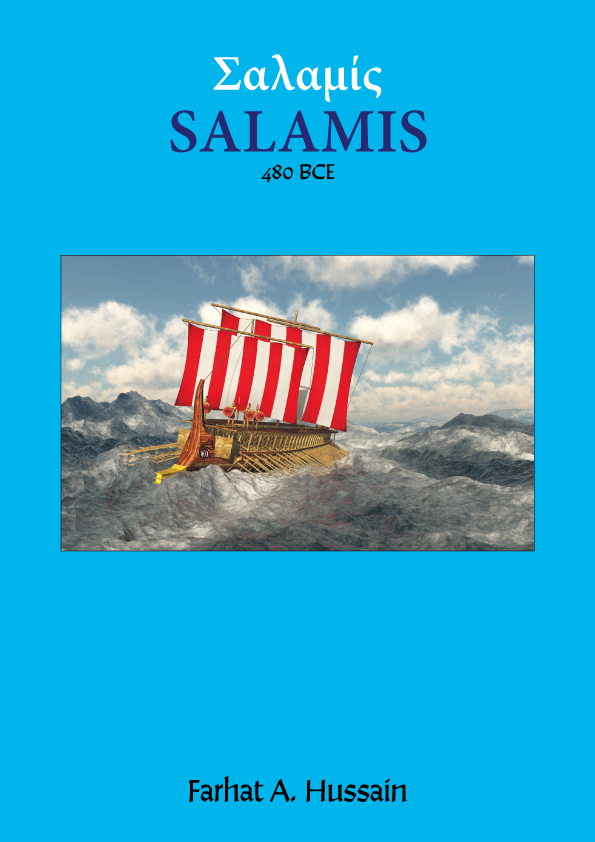
Salamis (480 BCE)
Author: Farhat A. Hussain
c. 35,000 words
ISBN 978-1-0686653-4-9
Pagination, format and price to be announced
Date of publication: To be announced
Celebrating the victory of Athens and her allies against the military encroachment of the Achaemenid Empire in relation to the Second Persian Invasion of Greece (480-479 BCE), this study evaluates the causes and conduct of this invasion and the Battle of Salamis. The composition of the opposing fleets is explored, as are the ships and men that were deployed. In refuting a simplistic narrative this work demonstrates the complexities of the age as substantive numbers of Greek, in addition to allied Middle Eastern nation ships, including those of Egypt and Phoenicia were part of the Achaemenid fleet of King Xerxes and many states in Greece refused to aid the Greek allies whilst many others, including Sparta, did so. The role of key personalities on both sides is assessed and the scale and ability of the Achaemenid army and navy present in and around Greece, including the very large-scale logistics deployed, underlined that also adds much to the significance of the Greek allied victory against the first world empire and political, economic, cultural and military superpower in history. Both an overview and nuance of the Battle itself are provided, including elements not always addressed in various studies. How Themistocles of Athens turned the tide against the invaders is highlighted, in conjunction with other factors whose immediate and long-term implications are assessed, including the decisive Greek allied initiatives to defeat the remaining Achaemenid forces on the mainland and across the sea. Described by various scholars as an engaging and dynamic study of this subject and issues examined, this recently authored work provides an up-to-date examination of this subject, many years after the author first came into contact with this period as a student of naval and military history. Very well referenced concerning primary and secondary sources throughout and supported with colour maps.
Contents
Introduction
Historiography
Introduction
Scope and nature of primary sources
Absence of Persian sources
Secondary sources
Interaction of cultures and civilizations
Proximity
Geography
Causes of the war
The First Persian Invasion of Greece
The Second Persian Invasion of Greece
Key Persons
Xerxes
Mardonius
Themistocles
Armies
Size
Soldiers, organisation and weapons
Achaemenid army
Troop composition
Armour and weapons
Immortals, cavalry and army standards, unit types and sizes
Greek armies
Overview and weapons
The phalanx
Size of fleets
The Achaemenid fleet
The allied Greek fleet
Warships
Greek ships
Achaemenid ships
Crossing the Hellespont
Movement south
Overview
Battle of Thermopylae
Battle of Artemisium
The Battle of Salamis
War reportage
The wind
Impact
Immediate
Long-term
Flight of Themistocles
Conclusion
Bibliography
‘Based on a thorough engagement with the latest scholarship and ancient sources, this important new and splendid study by Farhat A. Hussain demonstrates why history is a debate without end, not a conclusion to be written by those on one side of events. While we know that the Greek allies won a great victory at the Battle of Salamis, the turning point of the Second Persian invasion of Greece, the meaning of the event has been used to argue for many causes, notably the superiority of Europe over Asia, something no-one at the time believed. Freed from this cultural analysis the strategy and tactics of the battle can be analysed, victory and defeat explained, and the outcome stripped of contemporary and subsequent hyperbole. Battles, for good or ill, are decided by human action, not intangible elements. The Greeks won because they lured the Persians into an ambush that cancelled out their superiority in skill and numbers, while most of the ‘Persian’ Ships were manned by Greek and Phoenician seamen. At the time no-one thought the battle had demonstrated European ‘superiority’; an argument created by later European authors, to serve very different agendas.’
Andrew Lambert FKC
Laughton Professor of Naval History, Kings College, London
Author of Seapower States, Yale 2018.
‘Farhat Hussain’s text on the Battle of Salamis (480 BCE) provides a thoroughly researched, detailed and non-partisan view of one of the most seminal battles of history. Notable is the researcher’s examination of the historiography, the primary sources (with an excellent addressing of the question of the dearth of Persian sources) and the array of secondary sources which have been accessed for this study. The armies of the protagonists (Achaemenid and Hellenic) are scrutinized in exhaustive detail, not in isolation but in consideration of geographical factors and the key personages of Xerxes, Themistocles and Mardonius. Of notable value for this study is balanced discussion provided by the researcher with respect to the cultural interactions and exchanges between the Achaemenid and Hellenic civilizations. The organisation of the study, its attention to detail in text and colour map illustrations, lucid communication and clarity of arguments is also concomitant to the conveying of a panoramic gestalt of developments and pertaining debates.’
Dr Kaveh Farrokh
Specialist and author of military history of the Achaemenid Empire and Ancient Persia
Formerly lecturer and reader at the University of British Columbia and
Methodologica University, Paris.